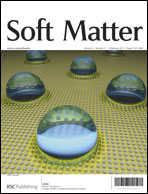Surface quaternized cellulose nanofibrils with high water absorbency and adsorption capacity for anionic dyes†
Abstract
Surface quaternized cellulose nanofibrils were mechanically disintegrated from wood pulp that was pretreated through a reaction with glycidyltrimethylammonium chloride. The resulting quaternized cellulose nanofibrils (Q-NFC) with trimethylammonium chloride contents of 0.59–2.31 mmol g−1 were characterized by conductometric titration, X-ray diffraction (XRD), Fourier transform infrared spectroscopy (FTIR), field emission scanning electron microscopy (FE-SEM), and atomic force microscopy (AFM). When the trimethylammonium chloride content on cellulose reached approximately 0.79 mmol g−1 corresponding to a degree of substitution of 0.13 per bulk anhydroglucose unit, highly viscous and transparent aqueous dispersions of cellulose nanofibrils were obtained by mechanical homogenization of the chemically pretreated cellulose/water slurries. AFM observation showed that the dispersions consisted of individualized cellulose I nanofibrils 1.6–2.1 nm in width and 1.3–2.0 μm in length. Cellulose nanopapers prepared from the Q-NFC aqueous dispersions exhibited high tensile strength (ca. 200 MPa) and Young's modulus (ca. 10 GPa) despite high porosity (37–48%). The nanopapers also demonstrated ultrahigh water absorbency (750 g g−1) with high surface cationic charge density. Stable hydrogels were obtained after swelling the nanopaper in water. The Q-NFC nanofibrils also possessed high anionic dye adsorption capability. The adsorption capacity increased with increasing trimethylammonium chloride content on cellulose.


 Please wait while we load your content...
Please wait while we load your content...